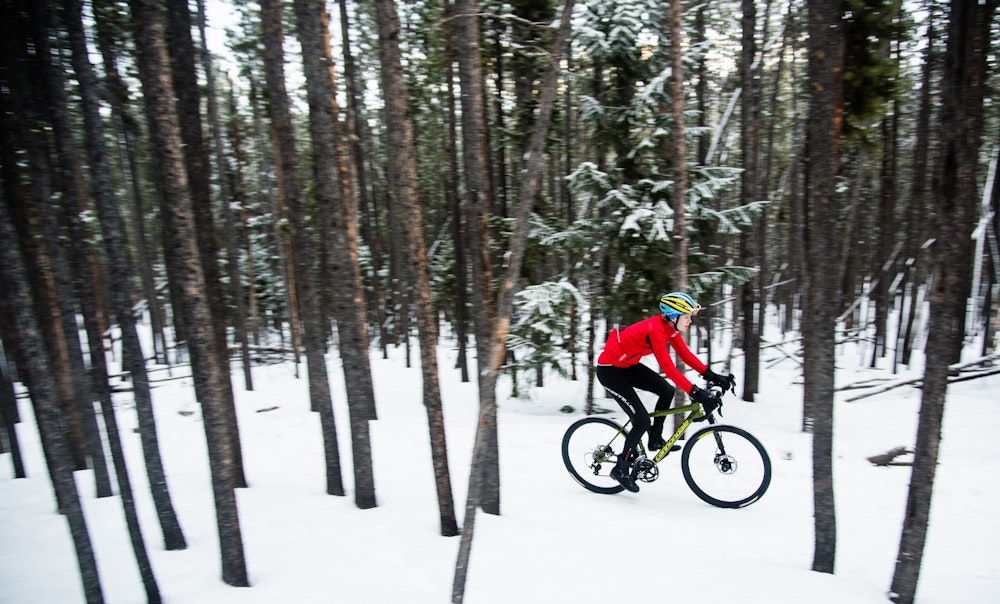Last week we got our first snow of the season here in the Pacific Northwest. As the puffy flakes came down from the sky that evening, I was overcome with that kid-like joy and set my alarm extra early so I could make the most of that untouched snow and those traffic-free roads. And sure enough, the whole city became a playground that next morning. I grabbed my cyclocross bike and rushed outside along with all the neighborhood kids and their sleds.
While most cyclists turn to their trainers at the first sight of snow (or the miserable 34 degrees and rain), winter riding can be really fun and rewarding, all it takes is some preparation and proper gear to stay warm and safe.
Here are some valuable tips on how to stay warm on the bike so that you can extend the outdoor riding season throughout the winter.

WHAT I LEARNED FROM RACING IN SUB-ZERO CONDITIONS
I knew the two days of racing were going to be interesting when I woke up that first morning to find that the outside world had been covered in a fresh, white blanket of puffy snow. It continued to snow all day.
As my teammates and I ventured out to pre-ride the cyclocross course, temperatures were plummeting quickly. -15°C…-16°C…-17°C. A brutally cold wind chill made it even worse.
It took all of 10 minutes for my rear V-brakes to freeze up, and I was unable to use them for the entirety of the ride.
The course hadn’t quite been laid out and cleared yet so we plowed through the 10 centimeters of fresh snow. My fingers were aching painfully. My toes soon went numb.
Yet, despite the harsh conditions, it was terribly fun to play in the snow. I felt like a kid.
Overnight, more snow fell and the wind chill reached near record lows, forcing the city to cancel its annual Christmas parade scheduled for that weekend. Yet, in true cyclocross-spirit, the racing continued.
It got so cold that, after my total disaster of a slip-and-slide first race, I was standing in the beer garden watching the men’s race and the foam of the freshly-poured pint of beer froze before I could even drink it.
Riding in those conditions in just a thin layer of spandex is probably a bit extreme, but I did learn some tips on how to make cold weather riding manageable and fun, and have since then enjoyed several more pleasant outings in snow.
LEAVE THE ROAD BIKE AT HOME
If you’re going to play in snowy conditions, leave your road bike at home and opt for a cyclocross or mountain bike instead. The knobby tires and clearance goes a long way. Same goes for the pedals and shoes. The likelihood that you’ll end up falling over or walking your bike for bits is greater in snow, so wear shoes you can walk in.
LUBE, DE-ICER AND NON-STICK COOKING SPRAY
These three items, applied strategically, will keep your bike running in even the coldest conditions.
Apply lube to a clean bike as you normally would. Then, carefully spray de-icer on your brake springs, your derailleurs and pedals spindles. Finally, to keep snow from sticking to your bike, apply the non-stick cooking spray to your pedals, derailleurs and the underside of your frame. Spray the bottom of your shoes, too.
SURGICAL GLOVES AND PLASTIC BAGS
Wear multiple layers of gloves. The problem with biking is that you can’t just throw on some mittens and call it good. You need to keep a certain level of dexterity to shift and brake.
Start with wearing surgical gloves. These thin layers of latex provided wind- and water-proof protection. Also, they do not breathe whatsoever, which in this case was a good thing as they trap in whatever warmth comes from your hands. If it’s really cold, follow up with a thin wool liner. Finish with the warmest cycling gloves you own. I use full neoprene Glacier Gloves.
In extremely cold temperatures, however, nothing will keep your fingers from going numb until you bring your heart rate up. Expect to have numb hands for the first 20 or so minutes of the ride.
To keep your feet warm, try layers of thinner socks versus one layer of super thick socks to keep the bulk down and your shoes from fitting too tight. Then, slip your toes in a plastic sandwich baggie to shield them from the cold wind. This is also a good trick for riding in the rain without shoes covers!
BUFF
Buffs offer versatile protection. One can wear them in many different ways – as a scarf, headband, balaclava or skullcap – but I mainly use mine to keep my neck warm.
HEADBAND OR HAT
Your comfort level will significantly improve from not having painfully cold ears.
VASELINE
Not only does Vaseline prevent your skin from drying out, it also offers a nice layer of protection from the icy cold wind. Apply Vaseline to your exposed lips, chin, nose and cheeks.
EMBROCATION
Use liberally, especially if you have exposed knees (as I tend to do in ‘cross).
RAIN PANTS
If you’re just playing in the snow (versus racing), rain pants add an extra layer of warmth and they keep you dry when, inevitably, you fall over in the snow.
SPIN
Get out of the big gears and spin, the speedy movement helps your core warm up much more quickly. Once your core is warm, your fingers will thaw out. Also, hills are your friend!
TOO COLD?
If you decide that it's just too cold for you, we can't blame you. But you can keep yourself occupied by jumping on a bike trainer, or fill the time by playing some indoor games like ping pong, foosball or even pool.
[externalhotoffer group="EHO_1"]
This article was originally published on cyclingtips.com
Follow BikeExchange: Email | Facebook | Twitter | Instagram | YouTube | STRAVA




